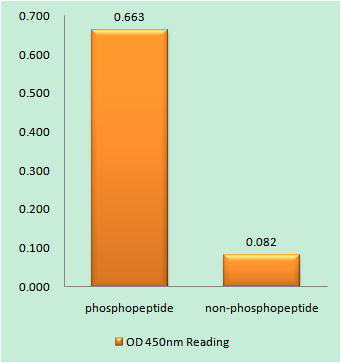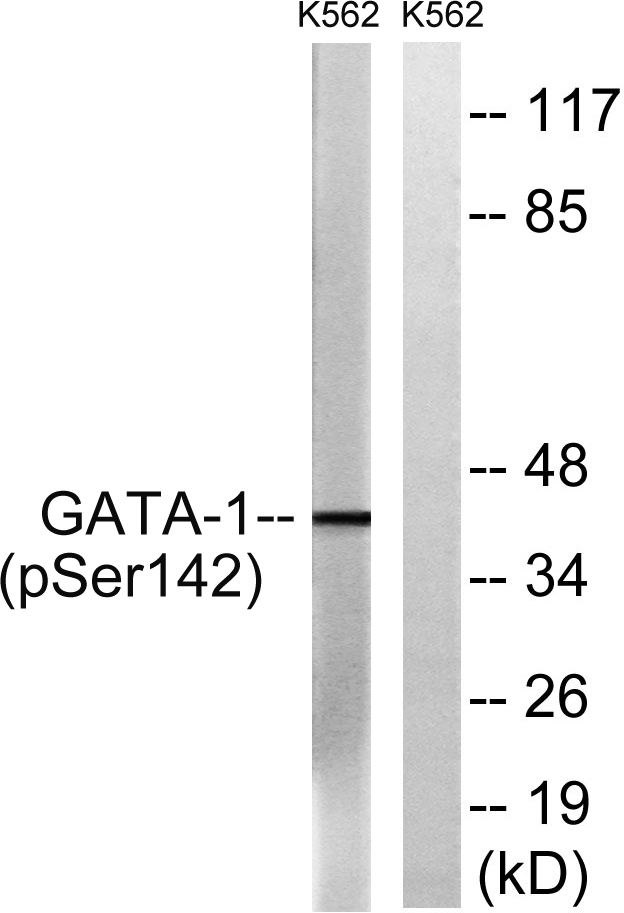GATA-1 (phospho Ser142) Polyclonal Antibody
- Catalog No.:YP0952
- Applications:WB;IHC;IF;IP;ELISA
- Reactivity:Human;Mouse;Rat
- Target:
- GATA-1
- Gene Name:
- GATA1
- Protein Name:
- Erythroid transcription factor
- Human Gene Id:
- 2623
- Human Swiss Prot No:
- P15976
- Mouse Gene Id:
- 14460
- Mouse Swiss Prot No:
- P17679
- Rat Gene Id:
- 1.00911e+008
- Rat Swiss Prot No:
- P43429
- Immunogen:
- The antiserum was produced against synthesized peptide derived from human GATA1 around the phosphorylation site of Ser142. AA range:109-158
- Specificity:
- Phospho-GATA-1 (S142) Polyclonal Antibody detects endogenous levels of GATA-1 protein only when phosphorylated at S142.
- Formulation:
- Liquid in PBS containing 50% glycerol, 0.5% BSA and 0.02% sodium azide.
- Source:
- Polyclonal, Rabbit,IgG
- Dilution:
- WB 1:500 - 1:2000. IHC 1:100 - 1:300. Immunoprecipitation: 2-5 ug:mg lysate. ELISA: 1:5000.. IF 1:50-200
- Purification:
- The antibody was affinity-purified from rabbit antiserum by affinity-chromatography using epitope-specific immunogen.
- Concentration:
- 1 mg/ml
- Storage Stability:
- -15°C to -25°C/1 year(Do not lower than -25°C)
- Other Name:
- GATA1;ERYF1;GF1;Erythroid transcription factor;Eryf1;GATA-binding factor 1;GATA-1;GF-1;NF-E1 DNA-binding protein
- Observed Band(KD):
- 40kD
- Background:
- This gene encodes a protein which belongs to the GATA family of transcription factors. The protein plays an important role in erythroid development by regulating the switch of fetal hemoglobin to adult hemoglobin. Mutations in this gene have been associated with X-linked dyserythropoietic anemia and thrombocytopenia. [provided by RefSeq, Jul 2008],
- Function:
- disease:Defects in GATA1 are the cause of X-linked dyserythropoietic anemia and thrombocytopenia (XDAT) [MIM:300367]. XDAT is a disorder characterized by erythrocytes with abnormal size and shape, and paucity of platelets in peripheral blood. The bone marrow contains abundant and abnormally small megakaryocytes.,disease:Defects in GATA1 are the cause of X-linked thrombocytopenia with beta-thalassemia (XLTT) [MIM:314050]; also called thrombocytopenia, platelet dysfunction, hemolysis, and imbalanced globin synthesis. The disease consists of an unusual form of thrombocytopenia with beta-thalassemia. Patients have splenomegaly and petechiae, moderate thrombocytopenia, prolonged bleeding time due to platelet dysfunction, reticulocytosis and unbalanced (hemo)globin chain synthesis resembling that of beta-thalassemia minor.,domain:The two fingers are functionally distinct and cooperate to achie
- Subcellular Location:
- Nucleus.
- Expression:
- Erythrocytes.
- June 19-2018
- WESTERN IMMUNOBLOTTING PROTOCOL
- June 19-2018
- IMMUNOHISTOCHEMISTRY-PARAFFIN PROTOCOL
- June 19-2018
- IMMUNOFLUORESCENCE PROTOCOL
- September 08-2020
- FLOW-CYTOMEYRT-PROTOCOL
- May 20-2022
- Cell-Based ELISA│解您多样本WB检测之困扰
- July 13-2018
- CELL-BASED-ELISA-PROTOCOL-FOR-ACETYL-PROTEIN
- July 13-2018
- CELL-BASED-ELISA-PROTOCOL-FOR-PHOSPHO-PROTEIN
- July 13-2018
- Antibody-FAQs
- Products Images

- Enzyme-Linked Immunosorbent Assay (Phospho-ELISA) for Immunogen Phosphopeptide (Phospho-left) and Non-Phosphopeptide (Phospho-right), using GATA1 (Phospho-Ser142) Antibody

- Immunohistochemistry analysis of paraffin-embedded human breast carcinoma, using GATA1 (Phospho-Ser142) Antibody. The picture on the right is blocked with the phospho peptide.

- Western blot analysis of lysates from K562 cells, using GATA1 (Phospho-Ser142) Antibody. The lane on the right is blocked with the phospho peptide.



